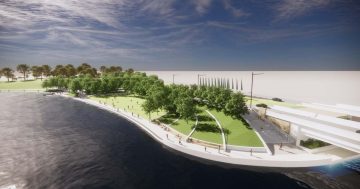
Heritage lovers have been saddened and angered by the impact of changes to Blundells Cottage. Photos: George Tsotsos.
Landscaping upgrades to the much-treasured and historic Blundells Cottage in the Parliamentary Triangle have appalled many Canberrans.
New paving and steps with fawn edging and protruding steel handrails clash with the rustic iron and stone cottage, the last remaining pre-Federal Capital residence in the Parliamentary Triangle.
A surprised, ‘saddened’ urban planner and architect David Flannery posted the changes on Facebook, commenting that “.. the new paving works are so out of context with the character of this early and significant pastoral era cottage”.
Social media followers did not hold back in response: “Appalling,” says one post. “Are you kidding?” says another. A Facebook post from abroad asks where the historical consultants were when “this abomination was taking shape?”

Handrails and steps are building requirements but critics say the choices are out of step with the heritage site.
“It saddens me seeing building after building either modernised like this or hit by the wrecking ball here in Toronto, Canada. Our government has no appreciation for the preservation of historical architecture and it seems Australia may be a bit the same.”
While not based on a historic element, the new handrail was required to ensure the landscape works were designed and constructed to required building standards, the NCA said in a statement.
Consultation was carried out in 2012 when GML Heritage prepared a heritage master plan. A plan was also prepared for the landscaping component, according to the NCA. The latest work is worth about $800,000.
“Extensive consultation was undertaken as part of this project including stakeholders like the then Department of Sustainability, Environment, Water Population and Communities, ACT Heritage Council, ACT Historic Places, National Trust of Australia (ACT) and the Canberra District Historical Society”, the NCA says.
“Extensive conservation works were also undertaken on the timber slab shed. Late 20th elements that were not part of the domestic history of the Cottage, like the picket fence, were removed”.

Blundells Cottage is the last remaining pre-Federal building in the Parliamentary Triangle.
The National Capital Authority, which has been responsible for renovations, says on its website that the stone dwelling was built in 1860 to house Duntroon’s head ploughman, William Ginn, and his family (1860-1874). It was then occupied by George Blundell, a Duntroon bullock driver and his family (1874-1933) and finally by shepherd Harry Oldfield and his wife Alice (1933-1958).
It has long been regarded as a valuable relic of Canberra’s early days. The NCA says Blundells Cottage is an important historical place that illustrates life in pre-Federal Canberra. As a farm cottage, it tells the story of the workers who settled and built Canberra during the 19 and early 20th century.





















